The Best Way to Find Old Maps for Genealogy at the David Rumsey Website
Old maps are vitally important for genealogy because the characteristics of a location can change in many ways over time. Historic maps help us understand the world as it was at the time our ancestors lived.
Here is a short list of just a few of the things that may have changed:
- Street addresses
- roads
- town names
- county boundaries
- waterways that may have been filled in or opened up
- railway lines
In fact, the country itself where they lived may be a completely different country. For example, my German ancestors lived in Prussia in the 19th century. Today, that area is part of Poland. Therefore, all of the village names have been changed to Polish names.
The David Rumsey Map Collection is an excellent place to go to find maps of your ancestors homeland for free.
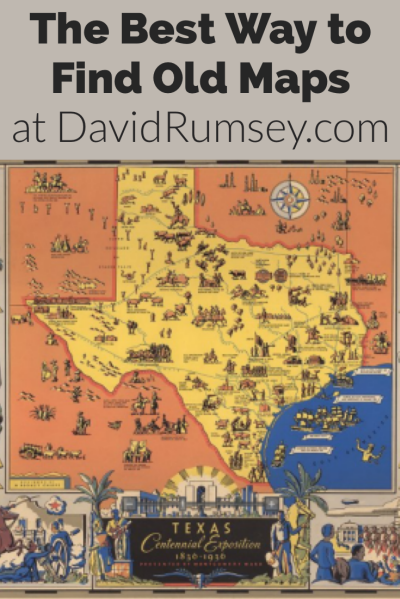
Watch the Map Search Video
I’m going to explain the 7 steps to finding the maps you need for your genealogy research at this wonderful website! I highly recommend that you watch the short video below to see it in action as you read. The player will stay with you as you scroll down the page.
Step 1: Go to the David Rumsey Map Collection Website
The first thing you need to do is go to the David Rumsey website here. You’ll be greeted on the home page with glorious historic maps. (Stay focused because it’s easy to get distracted by all the fascinating maps!)
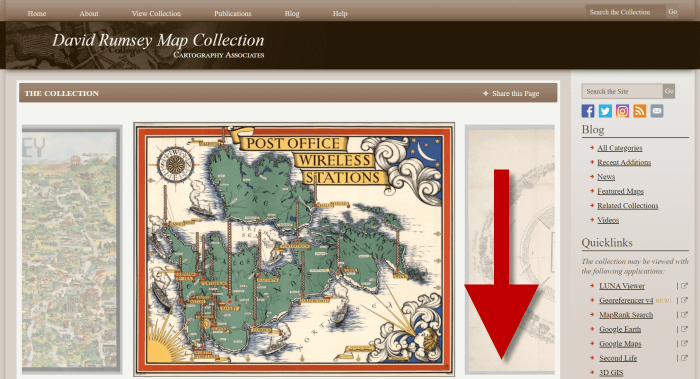
Scroll down on the David Rumsey website home page.
Step 2: Scroll Down to the Bottom of the David Rumsey Home Page
While you can search for a place name in the search box at the top of the page, there’s a better way to search. Scroll down the page until you get to Featured App: MapRank Search (it’s almost at the bottom.)
Step 3: Launch Map Rank Search
The Featured App – MapRank Search is the best place to search the website, but it’s easy to miss because it’s not at the top. So go ahead and click the Launch MapRank button in the upper corner of this section.
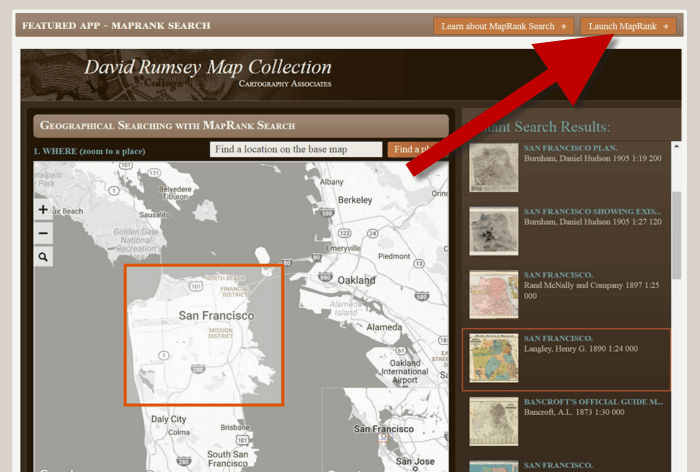
In the Featured App: MaprRank Search section click the Launch MapRank button
When you click the button it will open a new tab in your web browser which will take you to the Geographical Searching with MapRank Search page.
Quick Tip: The Fastest Way to MapRank Search
You can get there faster by going directly to https://rumsey.mapranksearch.com. I didn’t take you straight there from the beginning because I think it’s important to be aware of the home page and everything else it offers. However, today our focus is conducting the optimal search for old maps for you family history.
Step 4 Selecting the Map Time Frame
Here’s what the search page looks like.

The DavidRumsey.com search page
There are two very important features on this app page that will help you get the best results possible: the time slider and the location search box.
The time slider is located beneath the map:
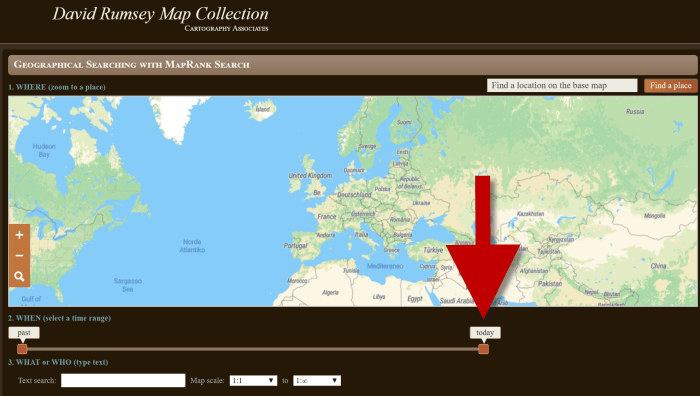
Time Slider for searching maps by time frame
It’s important to first select the time frame that you are searching because that will dictate the results you get when you search on the location name. (We’ll get to that in just a moment.)
There is a slider on each end of the timeline. Slide them to specify the desired time frame. In my example below, I’m looking for maps between 1800 and 1900.

Searching for maps between 1800 and 1900
As you move the sliders, you’ll notice that the maps in the right hand column will change. This is because only maps that fall within the range you select will be offered in the Instant Search Results column. But before we look at those, we need to type in a location in the next step.
Step 5: Selecting the Location
With your time frame selected, now you’re ready to type the location in the search box.
As you type, the app will make suggestions. But wait! Before you click the Find a Place button to run the search, look carefully at the list of suggested locations that may appear. Many locations names can be found in different areas. That is certainly the case with the name of the tiny village where my great grandfather was born: Kotten.

Type the location name to search the maps
In fact, the list doesn’t even include the Kotten I am looking for.
In cases like this, it is best to search a little more broadly. When Kotten was part of Prussia, it was located in Kreis Johannisburg so I could try searching for that. Even better might be to search for the largest city in the area since Kotten was such a tiny village. Arys was the largest city in the area.
Once you type in the name (and select from the suggestions if needed) click the Find a Place button just to the right of the search box.
Step 6: Analyze the Map Results
In my example of searching for the city of Arys (which is the name it was known by in the 19th century when it was part of East Prussia) the modern-day map displayed is actually Poland.
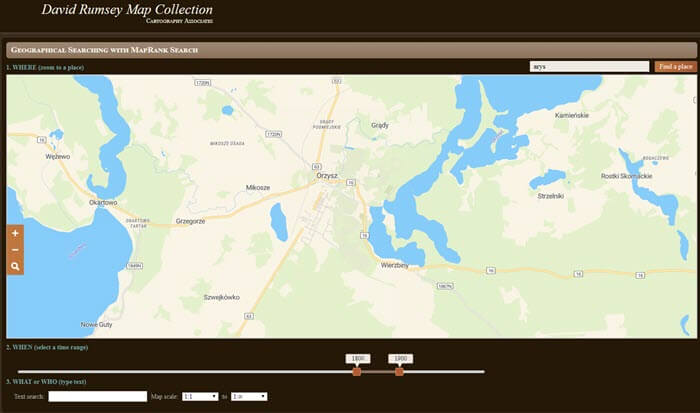
My search resulted in a map showing Orzysz, Poland
However, the David Rumsey website does a good job of cross-referencing the older German names (Arys) with the new Polish names (Orzysz). This is another reason why searching for a larger city works well. Larger cities are more likely to be in the David Rumsey system for cross-referencing, and of course they are easier to spot on the map. Generally speaking, the location you searched will be in the center of the display map.
Quick Tip: Verifying Location Names
Another quick way to cross-reference location names (or verify your findings in David Rumsey) is by searching for the name in Google Earth. In the example below, I typed in the Prussian city of Arys. Google Earth will offer options if more than one matching result exists.
I was a bit surprised to see “Arys” as one of the three listed results since it is not called that today. When I clicked Arys it took me to the city of Arys in the Turkistan Region of Kazakhstan, far away from Poland! Clicking Orzysz in the results list took me to the area of Poland that was once East Prussia. This confirms the results I received at the David Rumsey website.
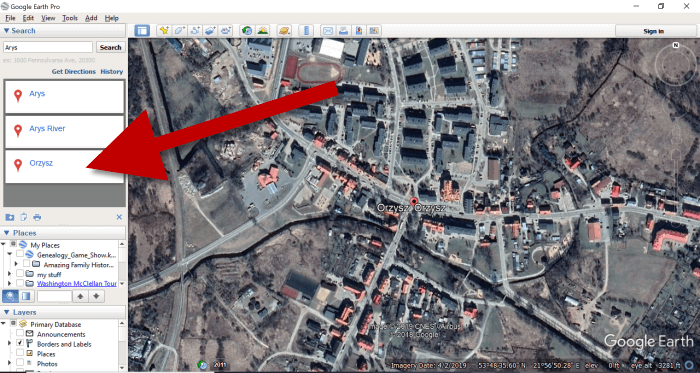
Learn more about using Google Earth for Genealogy by watching my free class here.
Now it’s time to review the map results listed in the Instant Search Results column on the right. Isn’t it fantastic that David Rumsey’s website not only presented me with the correct Polish location, but also maps published between 1800 and 1900 that include Arys? I think so!
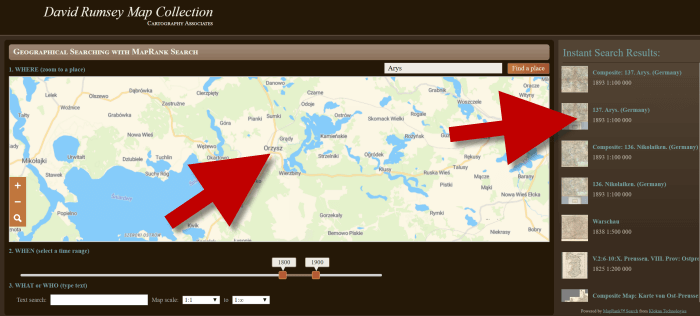
Map results appear in the column on the right side of the page.
Click the map you think best suits your needs. The map will open in in a new tab in your web browser. (These browsers tabs provide a nice bread crumb trail for your searching activities.)
All of the source information about the historic map that you chose will appear in the column on the left. (See the image in Step 7.) If you decide to use this map you’ll definitely want to accurately cite the source. Learn more about the importance of source citations here.
Step 7: Export the Map
I was delighted to find the village of Kotten on this map of Arys published by Reichsamt fur Landesaufnahme in 1893!
When you find a map that you would like to use for your family history research, export it to your computer. To do this, click Export in the upper right corner of the map and select the desired size. You can select a size ranging from Small Thumbnail to Extra Extra Large. Keep in mind that the larger the size, the more clarity you will have as you zoom in closer and closer. This is very important if you plan on using the map in an overlay in Google Earth. You can learn how to create your own map overlays in my video tutorial series on using Google Earth for genealogy available here, and in my book The Genealogist’s Google Toolbox.

Click “Export” to save the map to your computer.
Be patient while downloading to your computer because it can take several moments to export a large map. The saved file will probably be zipped. To unzip it, on a PC right-click and select Extract All from the pop-up menu. This creates an open version of the folder containing the map.
Get Started Finding Your Ancestral Locations in Old Maps
With this step-by-step process you are now ready to explore any given ancestor’s world through the rich details of historic maps. I can’t wait to hear what you discover! Please be sure to leave a comment below. And if you found this tutorial helpful, will you please share it with your friends on social media so we can help even more people find the homes of their ancestors? Thank you!
Gretna Green and Marriage Records
Gretna Green is a term you need to know if you are searching for marriage records. In this video professional genealogist J. Mark Lowe joins me to discuss Gretna Green: what it means, why it matters, and how Gretna Greens may have affected your ability to find your ancestors’ marriage records.
This is part 1 of a 2 part series with Mark Lowe on marriage records. Next week, Mark will walk us through a case study for finding marriage records relating to a Gretna Green in the United States.
Show Notes
(This transcription was edited for clarity)
About Professional Genealogist J. Mark Lowe
You can contact Mark through the Kentucky – Tennessee Research Associates
Mark: I’m getting old enough now that I could forget some of that. I really started realistically started when I was about seven years old. Not doing the same kind of work, not professionally, that sort of thing. But I got interested.
Lisa: We have so much in common. And I think one of the biggest things, of course, is genealogy. And I think most folks watching probably have seen you at some point, tell everybody how long you’ve been doing genealogy. When did all this start for you?
I lost my paternal grandmother. And so, with her loss, there were questions that I needed answers to. And I would ask my dad, and he knew lots of stuff. But he didn’t know everything I wanted to know, including, where everybody was married or that sort of thing. And I had an interest in that. He took me to an aunt, I had a couple of aunts who were in the DAR and there were interested a little bit, and he took me to visit one of those who took me to the county court clerk’s office up in Bowling Green, Kentucky.
Mr. Oval Motley was the clerk at that point. He was willing to work with a seven-year-old. He took me into the bowels of the courthouse and let me unfold marriage records and he made me explain to him, and he would ask “now do you understand this?” He and I transcribed – remember those great big pencils that we used in first and second grade, those great big ones the size of your thumb? – he had me transcribe whatever I was looking at, and then I would tell him what it meant. Or if I didn’t know, he would explain it to me. Now, I still had a seven-year-old mind, and I was loving it! I was learning it. And he said to me, “Do you see where the story goes?” And he said, “the story of your family and every other family who passed through this area are in these records.” And he said, “so if you learn how to listen to that story, you can hear what happened to them then.” I was hooked!
Lisa: I can imagine. What a great experience! How wonderful that he spoke to a seven-year-old like that and didn’t underestimate your interest or your capability.
You’ve got me beat by a year because I think I was eight years old when I first became interested in family history. I always tell people I was the only kid in grade school using her allowance to buy death certificates! But my grandmother hadn’t passed. But like the gentleman that you met at the courthouse when I asked her during a visit over the summer vacation, “Who are these people in your in your scrapbooks? I don’t recognize them. Why do you have strangers? You’re my grandma!” and she said, “that’s my family!” She stopped everything and sat down with me and answered questions and wrote things down. It’s that love and attention of an adult who’s willing to talk to you about it, right? I mean, what a difference that makes our kid!
Mark: It really doesn’t. In fact, my grandmother, when she was living, was someone who would give you attention. I would make up homework because I was not yet in school when she would come and stay with us. She would help my older brothers and sisters with homework. And so, I would say “you know, Mama Lowe I have homework too!” And she would do what you say and we would go through something, whatever I made up to go through, and I think that was why there was such a loss in part of that. And so, I think doing the research often about her family, those folks that I’d heard her talk about, helped me feel like she was there again. Telling me those stories.
Lisa: Yes. You get to uncover another connection, and another connection, and another connection to those beloved relatives that we knew. I still feel that way. When I find people I say to my Grandma, “I got one!” It’s exciting to know that we have that ongoing connection.
So, you called her mama Lowe?
Mark: Mama Lowe, yes. She was my dad’s mom. And my other grandmother was just Granny.
What Does Gretna Green Mean?
(06:29) Lisa: Let’s talk about marriage records. I know that you teach a lot on this subject and kind of blend it in with this concept of Gretna Green. I’ve heard of Gretna Green. There’s a place in Scotland. But you really help explain to people how this applies even to those of us in the US, and other countries. Let’s start off with talking about Gretna Green as a real place, and as an idea.
Mark: Exactly. There really is a place called Gretna Green. And as you mentioned, it is in Scotland. And the reason that it became famous is that England’s marriage laws were more rigid. Many couples found out that they could just cross the border over into Scotland, and they could get married much quicker, much easier without the same restrictions. It became so well known as people shared it with one another then they went to this little community called Gretna Green.
The marriage registers for those are available. So, if you actually have family who went to the Gretna Green in Scotland, the records are a database that’s available, both on FamilySearch and Ancestry. You can search those.
It became famous for an anvil, like a blacksmith anvil there. Often the story would go that they would go there to say they wanted to get married. The smithy was kind of a central place in the community. (Image Source: New Britain herald. [microfilm reel], July 10, 1924, Image 10.)

(Image Source: New Britain herald. [microfilm reel], July 10, 1924, Image 10.)
As we know, in the States, there’s been lots of “famous” areas where people wanted to get married, not always just because of marriage laws. Like often that would be going to Niagara Falls. A lot of folks went to Niagara Falls either on their honeymoon, or in many days earlier to get married It became a destination. And so, the Gretna Greens are not those necessarily romantic locations, but where perhaps the laws were easier. In fact, let’s look at some of those reasons.
Reasons Why People Married at a “Gretna Green”
- Age Requirements
(09:54) I think the biggest reason that many of our ancestors married somewhere besides where they lived was because of age requirements. That still applies today. That was the case in the first one I went to find in my family. There was a courthouse where I thought they would have gotten married. That’s where they lived. But there was no marriage record from my grandparents there. There could have been age requirements.
- Waiting Period
In some states, there’s a waiting period. So even though we could go get a license, it might be two, three, sometimes five days, sometimes a week, before the couple could actually get married. And for many folks, that was just too long.
- Medical Test Requirements
In the 20th century in particular we began to add some medical test requirements for marriage. And in many states today, there still is a blood test or various requirements, and that delays the marriage. Even today, in this county, several years ago, Tennessee required a blood test, and there was a lab that was set up just across from the courthouse where you could get your blood test done in one day. And so, we became kind of a Gretna Green for even other counties, because you could come here and
get your blood test and get married in the same day. That wasn’t true in other places. So that’s another reason.
- Costs
Sometimes it’s the cost of the license, or specific restrictions to clauses. Sometimes, besides age, there would be where you would have to have the proof of good conduct. Somebody had to actually, in some states, say that they knew you and that you would stand up for a good marriage and that you were of good conduct and that sort of thing. And in some cases, that would have prevented folks from going to a particular area.
- Alcohol and Party Restrictions
Certainly, near state lines and that sort of thing, people would want to have a party at their wedding. Perhaps they lived in a dry county. I grew up in a dry county. If you wanted to have alcohol or a party, then you would go somewhere else to get married.
- Train Transportation
For many folks going away is an important situation. They might hop on the train, or certainly, the whole idea of ‘oh, we want to get married somewhere special’, they would do that. So, I mentioned Niagara Falls. One of the other big areas where people went, if it was a destination wedding was Mammoth Cave. They wanted to go down in the cave. And particularly after the Civil War, 1870s and 1880s, there were many folks who would come down to Kentucky to do that. They would have on a fancy dress, but they would cover it with some kind of coveralls so they could crawl into the cave. Then they would get married and try to take some pictures. And so that would be a reason.
Lisa: It sounds like something kind of becomes a Gretna Green when word gets out that there’s an advantage to going there versus going here. I think about all the old movies in which they would go to Reno to get a divorce. That’s kind of the opposite Gretna Green, isn’t it?
Mark: It is, but it’s the same. It’s exactly the same thing. Same concept. People would get excited and would tell the information. So yes, yes, you can go there and a get a divorce quickly – same thing. And it’s amazing how the word got out about certain squires or JPs (Justice of the Peace). If you watched Andy Griffith growing up, people would come to him as the JP and get married.
Researchers like you and I, we’ve looked at these records, and we think “Wait, the record would have to be created in that place. And in some areas, it was he ease at which a JP could create a license where you didn’t have to go to the county seat. You could get married in that area with that JP. You could do everything right there. That certainly would have sped up the situation of having to go to a big city and wait in the long line and wait to be seen and go through the information. That’s certainly the reasons that they existed. and still exist today. They still do exist.
Lisa: Well, I imagine if a town or a city wanted to encourage people to come and kind of bring their filing fees with them, they would create a scenario where it’s really easy and they get that word out.
Mark: Sounds like a tourism opportunity! Yeah, come and get married here! We’ll make it work.
By the way, if you go look for that, you’re going to find that that exists, certainly. There are wedding chapels around the corner in certain cities just waiting for the opportunity.
Understanding Context: Marriage Statistics
(15:07) My grandparents would have gotten married right after World War I. I could see that they were married. But depending on the time period and where you are, if you’re in the States, there are records of agencies, around the world in virtually every country. For example, a book of marriage statistics. There’s one compiled by the Bureau of the Census. We’re used to looking at their populations counts and that sort of thing. But they also put out a marriage and divorce report, probably starting in the 1860s and continuing through today, actually. They are available on Google Books.
I’ve used the marriage statistics report. They don’t always have the marriage statistics report in every annual report. They’re also available on Hathitrust. This is the 1922 Report: Marriage and Divorce, Bureau of Census.
In it you can see counties where the marriage rate is higher than the state marriage rate. So, for example, if you were looking at West Virginia, Brooke County has a marriage rate higher than every other county in West Virginia. The next thing to do is pull a map up of that time period. If you look at Brook County, West Virginia it has that little lip that fits up between Ohio, and Pennsylvania. So, Brooke county is in West Virginia, and lays right between Ohio to its west, and Pennsylvania to the east. Ohio’s laws in Pennsylvania laws were more stringent than West Virginia’s law. So, Brooke County, was a popular destination. Number one, it’s close. And so many couples from Pennsylvania and Ohio, and sometimes folks who married somebody from Ohio, would meet in West Virginia, and have the marriage.
This statistical data kind of helps you predict an idea. If you have somebody and you can’t find their marriage record, you could start looking at the law in that time period and see which counties had a higher rate nearby.
I think that the next step is to take that one step further. Besides the statistics, try to figure out what was the cause. Hathitrust has lot of years listed of the Bureau of the Census Special Reports Marriage and Divorce. You can actually look based on the time period that you’re looking for.
If you’re interested in the laws for other countries, they’re often included in some of this book of the US Census, because it’s showing us what’s the comparable laws in France or Germany or Spain. They’re in the same book. So, you don’t have to go look necessarily outside. Sometimes you can actually use the same tools for that. So let me give an example.
In the 1909 edition I pulled up the requirements for Kentucky and Tennessee. When I’m looking at my grandparents who were living in Kentucky, I wonder why would they possibly go somewhere else to get married? This is the age before a parental consent is required. In Kentucky, you had to be 21. In Tennessee at that point, you only had to be 16. That’s five years, a significant difference right there, don’t you think? You can imagine that there would have been a lot of people who thought, wait a minute, we’re eighteen, and we want to get married. We’ve got to have parental consent? If that were the case, if your parents were all for that situation, then you could still do that. But if there was some question, then in Tennessee that wasn’t required at 16. In fact, before 1899 it mentions that that was put into place, that you had to be 16. Before that there wasn’t a specific written consent age. So that could have been the situation.
Those of us who research in Kentucky, for example, we understand the process that people who lived in the northern part of Kentucky crossed over to Indiana, because there was the lower age there. And the folks on the southern border, which is Tennessee, they crossed over into the northern Tennessee counties and got married, because it would have been easier.
With that in mind, you want to look at the laws that are in place. One of my favorite places to do that to quickly looking up the laws and statutes for the various states is one of the great summaries. Cornell law school has Marriage Laws of the Fifty States.
They’ve got it by state, and it helps you see the changes over time. It will tell you what the current marriage law is, but it will also help you see the changes in the past decades. I think that’s helpful for us to know. What was the law in place when your great aunt and uncle got married, and you’re trying to find where they were married? So that’s a great tool.
Lisa: Absolutely.
You specialize in your professional research, but many people who do it as a hobby don’t necessarily specialize. The advantage in specializing as a professional genealogist is that you really get to know all that context of an area. But that’s a strategy that all of us can use. We don’t have to be doing client work to take the time to get these kinds of resources. This is brilliant.
Mark: Yeah, because that is the question sometimes. I think that’s the one area that we can help sometimes is that people will say, “where do you where do you find that?” Well, it’s because you’ve already found it before. I think it’s when we share “hey, wait, this is a resource I would use” wherever I was. And I think I shared kind of three places there that would help you quickly, without getting into anything complicated.
And by the way, it would mention in the Census Bureau summary of laws, it would mention, if it required blood tests at a certain time period, what the tests were, it would indicate if there were special bonds. So, in regard to all those other reasons that folks might have gone to another location, those are in some of these summaries. So it’s not just an age thing. It’s got lots of other reasons. So again, it helps to know where to look, absolutely.
More Reasons to Go Looking for a Gretna Green Marriage
(23:45) In the case of my grandparents, I couldn’t ask her at that point, you know “where did y’all get married?” But sometimes there are clues that will cause you to look for a Gretna Green marriage.
I did look in the newspaper, but it just indicated their marriage. It did not indicate where they went to get married. I did find that in some other folks that I’ve looked for. In the newspaper account, it indicated that they went to a certain place or perhaps it was solemnized with the justice of the peace. Maybe the name was included. So, I would always do those newspaper searches.
Another reason to look for a Gretna Green marriage is rumors. They are often the best possibility. Somebody might say, “I think they ran off to so-and-so”. Occasionally that does pan out that people went pretty far to get married.
I always want to make sure that I’m looking in the right county. I love using the tool called the Atlas of Historical County Boundaries at the Newberry Library in Chicago. If I had grandparents who married in 1860 in a certain county, I want to know what the county boundary was at that time because maybe the current county didn’t exist yet. Maybe they were living in a different county at that time, and that’s where the marriage is. So, it’s always wise to make sure we’re looking at the same information and consistent across time.

The atlas of historical county boundaries
Learn more about the Atlas of Historical County Boundaries in these two articles:
- Atlas of Historical County Boundaries has been Updated
- How to find county boundaries with the Atlas of Historical County Boundaries in three steps
Lisa: I know that a lot of beginners in genealogy don’t always realize that you don’t always go to the current county seat for genealogy records. That what you were just showing there with that Atlas of Historical County Boundaries interactive map was the ability to be able to pick a point in time and see where the boundaries were at that time, because that’s where you would then search today. And it’s one of those things that until somebody tells you, you don’t really know when you’re new in genealogy. That’s a great tool.
Case Study: Finding Records for a Gretna Green Marriage
This is part 1 of a 2-part series with Mark Lowe on marriage records. Next time, Mark will walk us through a case study for finding marriage records relating to a Gretna Green in the United States.
Resources
Downloadable ad-free Show Notes handout for Premium Members. (Learn more and join Premium Membership here.)

Genealogy Gems Premium Membership Join Now.
How to Research Witnesses for Genealogy Success
Show Notes: You may not have been around when your ancestors lived, but there were witnesses to the important events in their life. Genealogist Robyn Smith shares her 3 step process from her new Family Tree Magazine article called Witness Testimony.
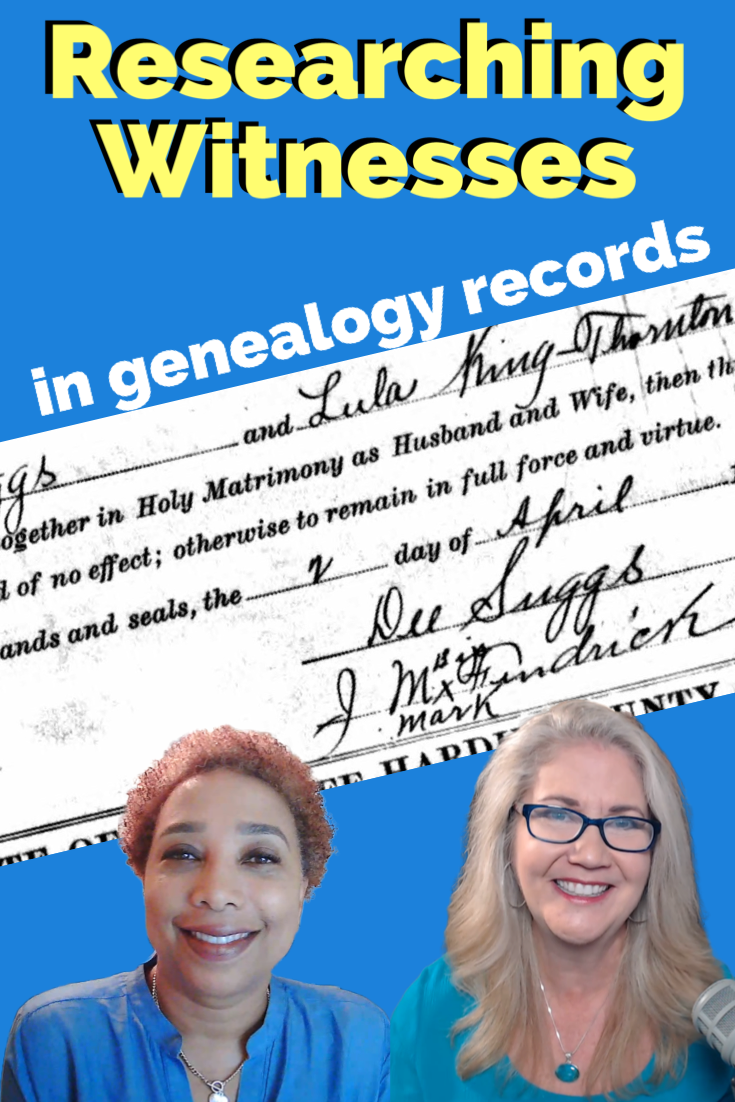
Pin it on Pinterest! Free Genealogy Video
Get ready to find out how the witnesses named on your ancestors’ records can help you bust brick walls in your genealogy research!
Watch the Video Interview
Show Notes
(This interview has been minimally edited for clarity)
Downloadable ad-free handout with time stamps and links. (Premium Membership required)
Why You Should be Researching Witnesses
Lisa: I learned a lot from your article in family tree magazine. And I wanted to chat with you a little bit about that, because I think researching our ancestors’ witnesses is fascinating, and it’s something that people don’t always think about. We may focus on the names we recognize and not so much on the ones that we don’t. I’d love to have you give your “elevator speech” if you will, as to why people should be taking the time to research witnesses.
Robyn: Most of us in the genealogy community eventually hear about this thing called “cluster research”. We hear this phrase, the FAN club that genealogist Elizabeth Shown Mills describes, where we take a look at the Friends, Associates and Neighbors of our ancestors. I would consider witnesses and bondsman in that FAN club, in that cluster.
Simply put, witnesses can help us find more family. That’s the benefit of researching these individuals and the records in which they find them. We can break through some brick walls. And this type of research can also tell us about the community ties and some of the customs in that time and place. So, witnesses and bondsman are always my secret research strategy.
What is a Bondsman?
Lisa: You mentioned bondsman, and that might be a new term for some folks. We might be used to seeing perhaps an immigration record or a birth record, and we see witness. What is a bondsman?
Robyn: This is one of those terms in genealogy that has a slightly different meaning historically than it does today. By bondsman we just mean someone who pledges a sum of money as a bond for another. Sometimes in these records, we might see that they’re called a Surety. You might see that term used. The difference between that and a witness is that there’s a financial obligation involved. I always try to tell people, it’s similar to cosigning a loan today. Most of us would probably not cosign a loan for people that we didn’t trust or that we didn’t know very well. And so, if you can keep that concept in your mind, that’s the value and the benefit of researching those witnesses and bondsman.
Lisa: Yes, when there’s a financial tie, there’s some kind of relationship there. And I guess if we can research them, that might lead us back to even more records about our own ancestor.
Genealogical Records that Include Witnesses
What kind of records will we find them in? In what type of records are we going to find witnesses and even more specifically, this term bondsman?
Robyn: The big one we think of, of course, is marriage bonds. We hear that phrase a lot. We may see them in marriage records, almost all deeds are going to have some sort of witness involved, and wills. Also, in probate records we will see executors and administrators often have to have bonds. If you’re going to serve as guardian to someone, typically, that person has to have a bond as well. And so those are sort of the big ones.
We can also think of court cases, civil court cases when you’re trying to secure someone’s appearance at a future court meeting. And I actually have seen the courts go after that bondsman if that person doesn’t show up. So, some of these records can get pretty juicy.
And of course, I think a lot of us are probably familiar with pension, military pension records and southern claims.
The only thing that I would caution people to watch out for is sometimes the witness is really just the county clerk, a local lawyer or local justice of the peace. So, it’s in researching that witness or that bondsman that you’ll find out the relationship if there is any, to the person of interest that you’re researching.
Lisa: That’s a really good point.
The Goal of Researching Witnesses in Records
Do you go after witnesses primarily because you’re wondering if they are related? Or is it also about that FAN principle where they may not be related, but researching them might actually lead me to more records about my own ancestor because of their will, depending on what the relationship was? Do both of those play into the way you approach them?
Robyn: I would say both. I’m actually really excited when I see a witness or bondsman because the curiosity serves you very well, in genealogical research, as we know. It’s a good thing to be a nosy genealogist. I want to know, why is that person there? That’s the question that I’m trying to answer. And more than a few times, it has led me to more family that I didn’t know about, particularly if that individual had a different surname.
Now, another gotcha is that sometimes they end up in the records with just their initials. So, we first have got to confirm who that person is before we’re ready to say that they’re related to our person of interest. So, there are some cautions that we may need to be aware of as we’re doing this research. But it’s another stone to overturn as you’re doing your research. And I love it when I see a person listed in a record. I’m excited!
Lisa: Me too! I feel like oh, my gosh, I finally have another avenue that I can pursue, particularly in a brick wall situation.
3 Step Process for Researching Witnesses
In the article, you provide a three-step research process. Will you walk us briefly through that process?
Step 1: Transcribe the Document
Robyn: The first thing that I do when I find a document concerning my ancestor that has a witness or bondsman, is to transcribe the document. I want to make sure that we all are comfortable with the practice of transcribing. Transcription ensures that you are actually reading every single word in that document. It’s going to help you notice all of the details that you might miss if you are just looking at it in its current format.
There are a lot of great free tools available to us for transcribing. There’s GenScriber, or there’s Trint. I would also recommend Family Tree Magazine’s cheat sheet on reading old handwriting. That becomes very handy when you’re doing this transcription.
Step 2: Do the Research
The second step is to then do the research. I always say you want to research in a variety of records. I actually research the person as if they were my ancestor already. That means I’m looking in census records and deed records and court records and everything else trying to establish who this person is. And the things that we learn along the way, are not just that this person is in this time and place, which is very important to us as genealogists, but it also gives us a hint as to how old the person was. It also gives us a hint about their literacy in terms of whether they sign with their mark or whether they sign with a signature. It is in this second step, doing the deep research, that you probably will uncover whether or not the person is related to your family.
Step 3: Research the Law
The third step is to research the laws because as we know, laws governed everything about the sources that we use a genealogy. They’re going to govern who can serve as a witness and a bondsman, how old that person has to be, and also how many were necessary.
We need to be aware that these laws are going to differ from state to state or colony or a locale and also throughout time. I look at the published date laws that I can find in databases like Internet Archive and Hathi Trust and Google Books but you and also visit your local library, law library, or archive. You may have to do some deep digging.
Those are the three steps that I recommend: transcribe the document, research the individuals you find, and make sure that you research the laws.
Lisa: Fantastic advice!
The Power of Transcribing Genealogy Records
I’d love to ask you a little bit more about transcription because I think that is a step that can be tempting to skip. People think, oh, well, I read it, I want to get going! I want to add people to my tree, and they are tempted to not take the time to transcribe. Will you tell us a little bit more about transcription? Why should we take that time? And what are we looking for, instead of just typing the words?
Robyn: Transcription to me is one of the basics of one of the basic genealogical skills I think we need to master in order to be successful, particularly once we start going back further in time and encountering those much more complicated problems. And it’s one of those basics that will remind you, if you don’t do it over and over again, that there’s a reason why it’s recommended in genealogy.
I can’t tell you how many phrases I’ve realized that I don’t fully understand as I’m transcribing. And Step one is to understand what that document is telling you. So, if there’s a phrase that I come across, I might email an archivist, or I might call one of my genealogy friends who’s got a little bit more experience in that particular time and place. Transcribing helps us to do that, and it helps us to understand.
When I transcribe, I also typically turn it into an abstract. I’m also making sure that I do a citation. So, to me, those are the building blocks of successful genealogical research.
I would also include keeping a research log and have a research plan. Those to me are very critical research building blocks to long-term success in genealogy.
I understand the impulse to want to skip transcribing. But I can tell you over and over again that I come across phrases that I thought I knew, but once I’m transcribing it, I really realized that I don’t. There are lots of wonderful webinars and classes that you can take on transcription that can teach you simple rules when you’re transcribing, and they’re easy to learn. They’re not complicated rules. And I think that once you start doing it, you’ll get more comfortable with the process. It will really become second nature.
I hope that I can encourage everyone with our conversation to do more of that transcribing. I did a lot of it earlier, not necessarily knowing or understanding all the rules, and now I’m going back and sort of revisiting those documents. It’s always amazing when things will jump out at you that you didn’t notice before, or it just didn’t resonate.
I always recommend having a genealogy buddy. You can say to them, hey, can you take a look at this and tell me what you see? You can have a fresh set of eyes look at it and ask you a question. I’m a genealogy junkie, so I find all of this really, really exciting to me. I kind of lean into it. We’ve all got other things to do in our lives. I try to do an hour here and there; it might be an hour this weekend. But I’m sort of just always working towards a goal. And that transcription, I tell you, that’s a key first step!
Witness Research Example
Lisa: I don’t mean to put you on the spot, but do you have a witness story or just something that you spotted that you just would love to share with us?
Robyn: I do! My mother’s family, my maternal family is from Tennessee. I was researching my second great-grandfather, Mike Fenricks in Tennessee, where he lived. Almost every source in his life asserts that he was born in Alabama. And so, this is a problem that a lot of genealogists have. I had no idea where in Alabama I’m even though I thoroughly went through all of the sources that were available in that time and place.
I noticed that he served as bondsman to a man named Dee Suggs. And then I noticed that he jointly took a couple of sharecropping deeds with this same man Dee Suggs.
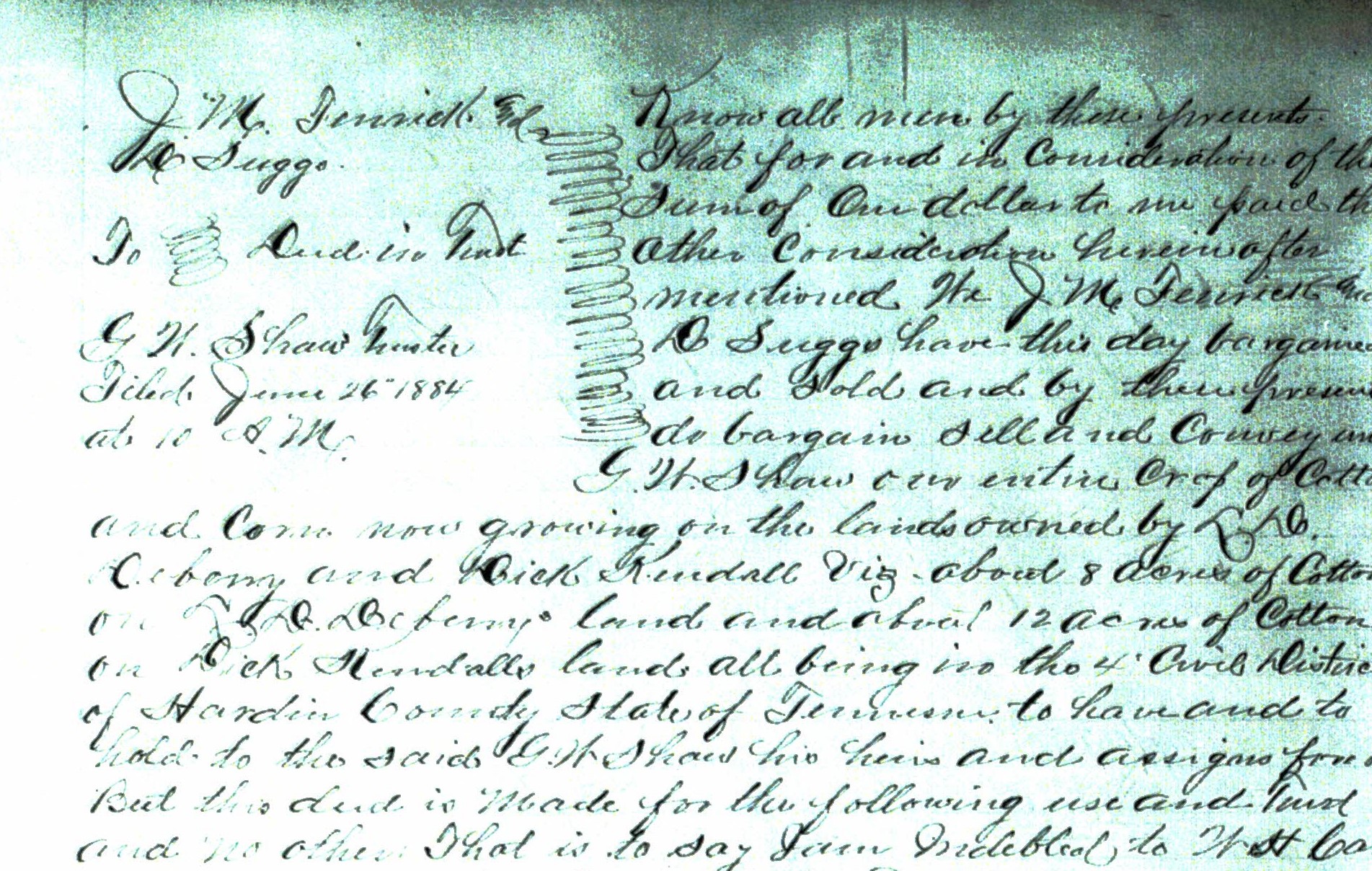
Sharecropping Deed: JM Fenrick and Dee Suggs
I also found him living in Dee Suggs’ house in 1920. So, the wheels start turning! Why is he interacting with this man and Dee Suggs who was also born in Alabama?

The Dee Suggs household in the 1920 U.S. Federal Census
So, when the records ran out, for my ancestor, I started researching Dee Suggs. And where did this witness lead me? Dee Suggs led me back to Lawrence County, Alabama. And in that 1870 census household was a man named Mike. And that man ended up being his brother, it was his half-brother. And the same man is my second great, great grandfather. They had migrated to Tennessee together. They had been formerly enslaved, and I found a Freedmen’s Bureau contract that their mother signed where she calls all of them, her children. The 1870 census doesn’t provide relationships, so I had that critical labor contract that said, Sofrona and her four children. And so, it makes all the sense in the world why he’s associating with him and living with him, and jointly, promising bond for him. It is because they were half-brothers!
Lisa: I knew you’d have a great story!
Robyn: That story is the crux of my cluster genealogy lecture that I do. I go into more details, but following Dee is what led me to that community and his place of origin in northern Alabama. It was very exciting.
Learn more about Robyn Smith
Lisa: And I know you bring many stories to your readers at Reclaiming Kin. Please tell us the URL address and what they will find there at your website.
Robyn: Thank you so much. The URL is www.reclaimingkin.com. I call it a genealogy teaching blog, and what I mean by that is, I might start off with something from my family history, but every single post is meant to teach a skill. And so, every post there talks about a methodology, a strategy or resource. It’s not just about my family history, it’s about helping all genealogists to grow their skills, and also meet the special challenges of researching the enslaved. I’d be really happy if your listeners would come to the blog, take a look, sign up for my mailing list. And I’ll send you a free PDF, all my favorite research tips.
Lisa: Robyn, thank you so much. We’ll all look forward to your article Witness Testimony in the Family Tree Magazine Jan / Feb 2023 issue. And I look forward to hopefully talking to you again soon.
Robyn: Thank you so much for having me on today, Lisa.
Learn more about Transcription
There’s so much more to learn about doing transcriptions! Check out my full-length Premium video class called Transcribing and Analyzing Historical Documents. It’s part of Premium Membership, and it is going to tell you everything you need to know about how to do transcription, the tools that I recommend, and so much more. And along with that video class, you also get the downloadable handout. Becoming a premium member has a lot of perks. Learn more here.
Resources
Downloadable ad-free Show Notes handout for Premium Members.
